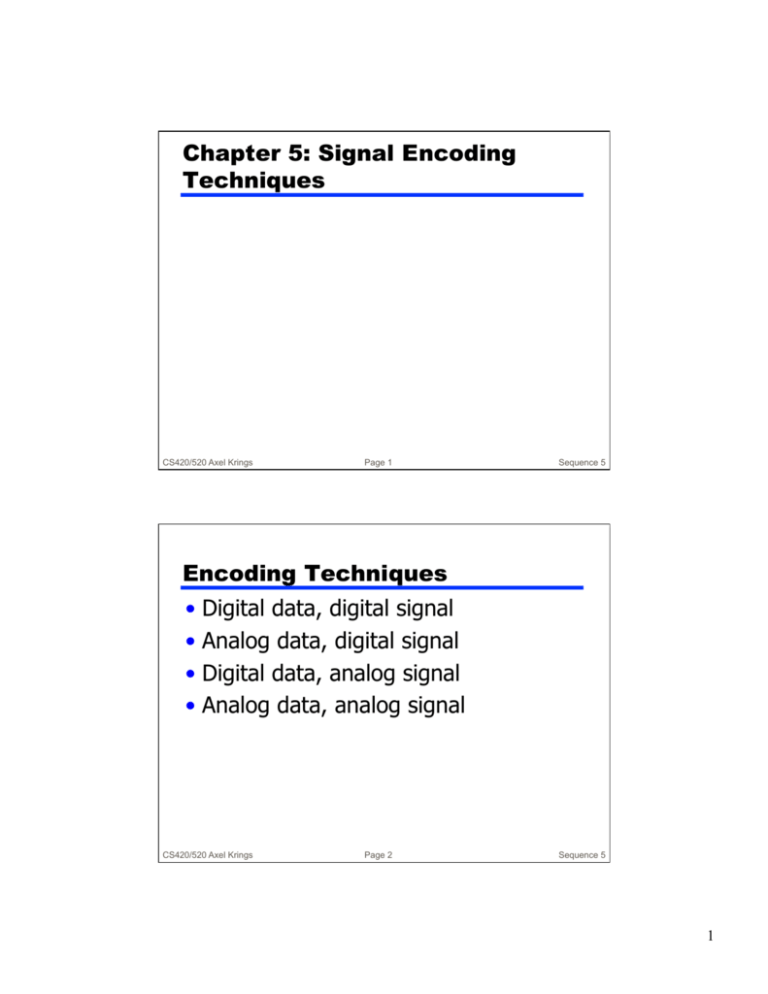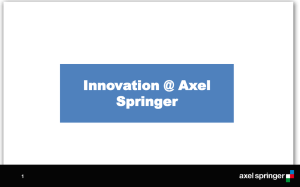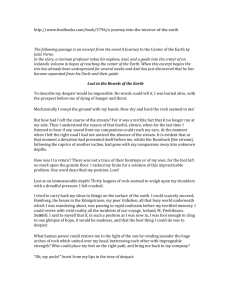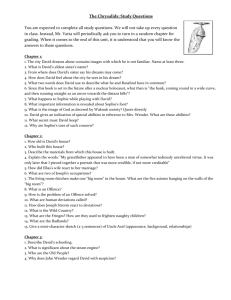Chapter 5: Signal Encoding Techniques Encoding Techniques
advertisement

Chapter 5: Signal Encoding
Techniques
CS420/520 Axel Krings
Page 1
Sequence 5
Encoding Techniques
• Digital data, digital signal
• Analog data, digital signal
• Digital data, analog signal
• Analog data, analog signal
CS420/520 Axel Krings
Page 2
Sequence 5
1
Digital Data, Digital Signal
• Digital signal
— Discrete, discontinuous voltage pulses
— Each pulse is a signal element
— Binary data encoded into signal elements
CS420/520 Axel Krings
Page 3
Sequence 5
Terms (1)
• Unipolar
— All signal elements have same sign
• Polar
— One logic state represented by positive voltage the
other by negative voltage
• Data rate
— Rate of data transmission in bits per second
• Duration or length of a bit
— Time taken for transmitter to emit the bit
CS420/520 Axel Krings
Page 4
Sequence 5
2
Terms (2)
• Modulation rate
— Rate at which the signal level changes
— Measured in baud = signal elements per
second
• Mark and Space
— Binary 1 and Binary 0 respectively
CS420/520 Axel Krings
Page 5
Sequence 5
Interpreting Signals
• Need to know
— Timing of bits - when they start and end
— Signal levels
• Factors affecting successful interpreting of
signals
— Signal to noise ratio
— Data rate
— Bandwidth
— Synchronization
CS420/520 Axel Krings
Page 6
Sequence 5
3
Comparison of Encoding
Schemes (1)
• Signal Spectrum
— Lack of high frequencies reduces required bandwidth
— Lack of DC component allows AC coupling via
transformer, providing isolation
— Concentrate power in the middle of the bandwidth
• Clocking
— Synchronizing transmitter and receiver
— External clock
— Sync mechanism based on signal
CS420/520 Axel Krings
Page 7
Sequence 5
Comparison of Encoding
Schemes (2)
• Error detection
— Can be built in to signal encoding
• Signal interference and noise immunity
— Some codes are better than others
• Cost and complexity
— Higher signal rate (& thus data rate) lead to higher
costs
— Some codes require signal rate greater than data rate
CS420/520 Axel Krings
Page 8
Sequence 5
4
Encoding Schemes
•
•
•
•
•
•
•
•
Nonreturn to Zero-Level (NRZ-L)
Nonreturn to Zero Inverted (NRZI)
Bipolar -AMI
Pseudoternary
Manchester
Differential Manchester
B8ZS
HDB3
CS420/520 Axel Krings
Page 9
Sequence 5
Nonreturn to Zero-Level (NRZ-L)
• Two different voltages for 0 and 1 bits
• Voltage constant during bit interval
— no transition, i.e. no return to zero voltage
— in general, absence of voltage for zero,
constant positive voltage for one
— More often, negative voltage for “1” value
and positive for the “0”
— This is NRZ-L
CS420/520 Axel Krings
Page 10
Sequence 5
5
Nonreturn to Zero Inverted
• Nonreturn to zero inverted on ones
— Constant voltage pulse for duration of bit
— Data encoded as presence or absence of
signal transition at beginning of bit time
— Transition denotes a binary 1
• (low to high or high to low)
— No transition denotes binary 0
— An example of differential encoding
CS420/520 Axel Krings
Page 11
Sequence 5
Page 12
Sequence 5
NRZ
CS420/520 Axel Krings
6
Differential Encoding
• Data represented by changes rather than
levels
— More reliable detection of transition rather
than level
— In complex transmission layouts it is easy to
lose sense of polarity
CS420/520 Axel Krings
Page 13
Sequence 5
NRZ pros and cons
• Pros
— Easy to engineer
— Make good use of bandwidth
• Cons
— dc component
— Lack of synchronization capability
• Used for magnetic recording
• Not often used for signal transmission
CS420/520 Axel Krings
Page 14
Sequence 5
7
Multilevel Binary
• Use more than two levels
• Bipolar-AMI
— “0” represented by no line signal
— “1” represented by positive or negative pulse
— “1” pulses alternate in polarity
— No loss of sync if a long string of “1”s (“0”
still a problem)
— No net dc component
— Lower bandwidth
— Easy error detection
CS420/520 Axel Krings
Page 15
Sequence 5
Pseudoternary
• “1” represented by absence of line signal
• “0” represented by alternating positive
and negative
• No advantage or disadvantage over
bipolar-AMI
CS420/520 Axel Krings
Page 16
Sequence 5
8
Bipolar-AMI and Pseudoternary
CS420/520 Axel Krings
Page 17
Sequence 5
Trade-Off for Multilevel Binary
• Not as efficient as NRZ
— Each signal element only represents one bit
— 3 level system could represent log23 = 1.58 bits
— Receiver must distinguish between three levels
(+A, -A, 0)
— Requires approx. 3dB more signal power for
same probability of bit error
CS420/520 Axel Krings
Page 18
Sequence 5
9
Biphase
• Manchester
— Transition in middle of each bit period
— Transition serves as clock and data
— Low to high represents one
— High to low represents zero
— Used by IEEE 802.3 (CSMA/CD, i.e. Ethernet)
CS420/520 Axel Krings
Page 19
Sequence 5
Biphase
• Differential Manchester
— Mid-bit transition is clocking only
— Transition at start of a bit period represents
zero
— No transition at start of a bit period
represents one
— Note: this is a differential encoding scheme
— Used by IEEE 802.5 (token ring)
CS420/520 Axel Krings
Page 20
Sequence 5
10
Manchester Encoding
CS420/520 Axel Krings
Page 21
Sequence 5
Differential Manchester
Encoding
CS420/520 Axel Krings
Page 22
Sequence 5
11
Biphase Pros and Cons
• Con
— At least one transition per bit time and possibly two
— Maximum modulation rate is twice NRZ
— Requires more bandwidth
• Pros
— Synchronization on mid bit transition (self clocking)
— No dc component
— Error detection
• Absence of expected transition
CS420/520 Axel Krings
Page 23
Sequence 5
Modulation Rate
CS420/520 Axel Krings
Page 24
Sequence 5
12
Scrambling
• Use scrambling to replace sequences that would
produce constant voltage
• Filling sequence
— Must produce enough transitions to sync
— Must be recognized by receiver and replace with
original
— Same length as original
•
•
•
•
No dc component
No long sequences of zero level line signal
No reduction in data rate
Error detection capability
CS420/520 Axel Krings
Page 25
Sequence 5
B8ZS
• Bipolar With 8 Zeros Substitution
• Based on bipolar-AMI
• If octet of all zeros and last voltage pulse
preceding was positive encode as 000+-0-+
• If octet of all zeros and last voltage pulse
preceding was negative encode as 000-+0+• Causes two violations of AMI code
• Unlikely to occur as a result of noise
• Receiver detects and interprets as octet of all
zeros
CS420/520 Axel Krings
Page 26
Sequence 5
13
Data Encoding
• HDB3 - (High Density Bipolar 3)
— Commonly used in Europe and Japan
— Similar to bipolar AMI, except that any string of four zeros is
replaced by a string with one code violation
— Rules:
• replace every string of 4 zeros by 000V
– V is a code violation
• this might result in DC components if consecutive strings of 4
zeros are encoded -- in this case the pattern B00V is used
– B is a level inversion and
– V is the code violation
• general rule: use patterns 000V and B00V such that the
violations alternate, thereby avoiding DC components
CS420/520 Axel Krings
Page 27
Sequence 5
B8ZS and HDB3
CS420/520 Axel Krings
Page 28
Sequence 5
14
Test your understanding and see solutions on next slide
0
1 0 0 1 1 0 0 0
NRZ-L
1
1
NRZI
Bipo.AMI
Pseudoternary
Manchester
Differential
Manchaster
CS420/520 Axel Krings
Page 29
0
1
0
0
Sequence 5
1
1
0
0
0
1
1
NRZ-L
NRZI
Bipolar-AMI
(most recent
preceding 1 bit has
negative voltage)
Pseudoternary
(most recent
preceding 0 bit has
negative voltage)
Manchester
Differential
Manchester
CS420/520 Axel Krings
Page 30
Sequence 5
Figure 5.2 Digital Signal Encoding Formats
15
Test your understanding and see solutions on next slide
1 1 0 0 0 0 0 0 0 0 1 1 0 0 0 0 0 1 0
Bipol.
AMI
B8ZS
HDB3
Example Sta97 pg106
CS420/520 Axel Krings
Page 31
1
1
0
0
0
Sequence 5
0
0
0
0
0
0
0
0 V B 0 V B
0
0
0 V B 0
1
1
0
0
0
0
0
1
0
Bipolar-AMI
B8ZS
0 V
B 0
0 V
HDB3
(odd number of 1s
since last substitution)
B = Valid bipolar signal
V = Bipolar violation
CS420/520 Axel Krings
Page 32
Figure 5.6 Encoding
Rules for B8ZS and HDB3
Sequence 5
16
Digital Data, Analog Signal
• Public telephone system
— 300Hz to 3400Hz
— Use modem (modulator-demodulator)
• Amplitude shift keying (ASK)
• Frequency shift keying (FSK)
• Phase shift keying (PSK)
CS420/520 Axel Krings
Page 33
Sequence 5
Amplitude Shift Keying
CS420/520 Axel Krings
Hal96 fig 2.18
Page 34
Sequence 5
17
Amplitude Shift Keying
• Amplitude Modulation
— carrier frequency
— signal to be modulated
— spectrum
CS420/520 Axel Krings
Hal96 fig 2.18
Page 35
Sequence 5
How does ASK work?
vc (t ) = cos ω c t
1 2
1
1
+ {cos ω 0t − cos 3ω 0t + cos 5ω 0t − ...}
2 π
3
5
v ASK (t ) = vc (t ) ⋅ vd (t )
vd (t ) =
1
2
1
cos ω c t + {cos ω c t ⋅ cos ω 0t − cos ω c t ⋅ cos 3ω 0t + ...}
2
π
3
Now, we know that
=
2 cos A cos B = cos( A − B) + cos( A + B)
Therefore we have:
CS420/520 Axel Krings
1
v ASK (t) = cos ω c t
2
1
+ {cos(ω c − ω 0 )t + cos(ω c + ω 0 )t
π
1
− [cos(ω c − 3ω 0 )t + cos(ω c + 3ω 0 )t] + ...}
3
Page 36
Sequence 5
€
18
Frequency Shift Keying
CS420/520 Axel Krings
Hal96 fig 2.19
Page 37
Sequence 5
Frequency Shift Keying
• Frequency Modulation
— different carrier frequencies
— signal to be modulated
— spectrum
CS420/520 Axel Krings
Hal96 fig 2.19
Page 38
Sequence 5
19
How does FSK work?
vFSK (t ) = cos ω1t ⋅ vd (t ) + cos ω 2t ⋅ vd ' (t )
The two carriers are ω1 and ω2 and vd ' (t ) = 1 − vd (t )
Therefore we have:
1 2
1
vFSK (t ) = cos ω1t{ + (cos ω 0t − cos 3ω 0t + ...)}
2 π
3
1 2
1
+ cos ω 2t{ − (cos ω 0t − cos 3ω 0t + ...)}
2 π
3
1
1
cos ω1t + {cos(ω1 − ω 0 )t + cos(ω1 + ω 0 )t
2
π
1
− cos(ω1 − 3ω 0 )t + cos(ω1 + 3ω 0 )t + ...}
3
1
1
+ cos ω 2t + {cos(ω 2 − ω 0 )t + cos(ω 2 + ω 0 )t
2
π
1
− cos(ω 2 − 3ω 0 )t + cos(ω 2 + 3ω 0 )t + ...}
3
vFSK (t ) =
CS420/520 Axel Krings
Page 39
Sequence 5
Phase Shift Keying
CS420/520 Axel Krings
Hal96 fig 2.21
Page 40
Sequence 5
20
Phase Shift Keying
• Phase Modulation
— phase of carrier defines data
— two versions
• phase coherent
• differential
— spectrum
Hal96 fig 2.21
CS420/520 Axel Krings
Page 41
Sequence 5
How does PSK work?
Carrier and bipolar data signal
vc (t ) = cos ω c t
vd (t ) =
4
1
1
{cos ω 0t − cos 3ω 0t + cos 5ω 0t − ...}
π
3
5
vPSK (t ) = vc (t ) ⋅ vd (t )
=
4
1
{cos ω c t ⋅ cos ω 0t − cos ω c t ⋅ cos 3ω 0t + ...}
π
3
With the usual simplification 2 cos A cos B = cos( A − B ) + cos( A + B ) we get:
1
{cos(ω c − ω 0 )t + cos(ω c + ω 0 )t
π
1
− cos(ω c − 3ω 0 )t + cos(ω c + 3ω 0 )t + ...}
3
vPSK (t ) =
CS420/520 Axel Krings
Page 42
Sequence 5
21
Phase Shift Keying
• Multilevel Phase Modulation Methods
— use multiple phases
— e.g. 4-PSK or quadrature phase shift keying QPSK
• (0o,90o,180o,270o)
— 4-PSK phase-time diagram
— 4-PSK phase diagram
— 16-QAM phase diagram
CS420/520 Axel Krings
Page 43
Sequence 5
Spread Spectrum
• Spread spectrum digital
communication systems
— developed initially for military
• spread the signal to make it hard to jam
• became known as “frequency-hopping”
• switches through a pseudo random
sequence of frequency assignments
CS420/520 Axel Krings
Page 44
Sequence 5
22
Data Signaling
• Transmitting on Analog Lines
— If we use existing telephone lines (PSTN) we
have to consider that they were created for
voice with effective bandwidth from 300Hz to
3400Hz or total of 3000Hz.
— We have to concern ourselves with two forms
of data.
• Analog data
• Digital data
CS420/520 Axel Krings
Page 45
Sequence 5
Modulation Techniques
CS420/520 Axel Krings
Page 46
Sequence 5
23
Amplitude Shift Keying
• Values represented by different amplitudes of
carrier
• Usually, one amplitude is zero
— i.e. presence and absence of carrier is used
•
•
•
•
Susceptible to sudden gain changes
Inefficient
Up to 1200bps on voice grade lines
Used over optical fiber
CS420/520 Axel Krings
Page 47
Sequence 5
Binary Frequency Shift Keying
• Most common form FSK is binary FSK (BFSK)
• Two binary values represented by two different
frequencies (near carrier)
• Less susceptible to error than ASK
• Up to 1200bps on voice grade lines
• High frequency radio
CS420/520 Axel Krings
Page 48
Sequence 5
24
Multiple FSK
•
•
•
•
More than two frequencies used
More bandwidth efficient
More prone to error
Each signalling element represents more than
one bit
CS420/520 Axel Krings
Page 49
Sequence 5
FSK on Voice Grade Line
CS420/520 Axel Krings
Page 50
Sequence 5
25
Phase Shift Keying
• Phase of carrier signal is shifted to represent
data
• Binary PSK
— Two phases represent two binary digits
• Differential PSK
— Phase shifted relative to previous transmission rather
than some reference signal
CS420/520 Axel Krings
Page 51
Sequence 5
Page 52
Sequence 5
Binary PSK
CS420/520 Axel Krings
26
Quadrature (four-level) PSK
• More efficient use by each signal element
representing more than one bit
— e.g. shifts of π/2 (90o)
— Each element represents two bits
— Can use 8 phase angles and have more than one
amplitude
— 9600bps modem use 12 angles, four of which have
two amplitudes
• Offset QPSK (OQPSK)
— also called “orthogonal QPSK”
— Delay in Q stream
CS420/520 Axel Krings
Page 53
Sequence 5
Example QPSK
• signals
11
01
00
10
€
€
π
s(t) = A cos(2 πfc t + )
4
3π
s(t) = A cos(2 πfc t + )
4
3π
s(t) = A cos(2 πfc t − )
4
π
s(t) = A cos(2 πfc t − )
4
€
€
CS420/520 Axel Krings
Page 54
Sequence 5
27
QPSK and OQPSK Modulators
QPSK signal:
s(t) =
1
1
I (t) cos 2 πfc t −
Q(t) sin2 πfc t
2
2
binary 1 and 0
€
CS420/520 Axel Krings
Page 55
Sequence 5
Examples of QPSF Waveforms
CS420/520 Axel Krings
Page 56
Sequence 5
28
Performance of Digital to
Analog Modulation Schemes
• Bandwidth
— ASK and PSK bandwidth directly related to bit rate
— FSK bandwidth is larger. Why?
— Note the difference in the derivation of the math in
Stallings compare to the previous arguments based
on the spectrum.
• In the presence of noise, bit error rate of PSK
and QPSK are about 3dB superior to ASK and
FSK
CS420/520 Axel Krings
Page 57
Sequence 5
Quadrature Amplitude
Modulation
• QAM used on asymmetric digital subscriber line
(ADSL) and some wireless
• Combination of ASK and PSK
• Send two different signals simultaneously on
same carrier frequency
— Use two copies of carrier, one shifted 90°
— Each carrier is ASK modulated
— Two independent signals over same medium
• binary 0 = absence of signal, binary 1 = carrier
• same holds for path that uses the shifted carrier
— Demodulate and combine for original binary output
CS420/520 Axel Krings
Page 58
Sequence 5
29
QAM Modulator
QAM signal:
s(t) = d1 (t) cos 2 πfc t + d 2 (t) sin2 πfc t
€
CS420/520 Axel Krings
Page 59
Sequence 5
QAM Levels
• Two level ASK
— Each of two streams in one of two states
— Four state system
• Essentially this is a four level ASK
— Combined stream in one of 16 states
• 64 and 256 state systems have been
implemented
• Improved data rate for given bandwidth
— Increased potential error rate
CS420/520 Axel Krings
Page 60
Sequence 5
30
Analog Data, Digital Signal
• Digitization
— Conversion of analog data into digital data
— Digital data can then be transmitted using NRZ-L
— Digital data can then be transmitted using code other
than NRZ-L
— Digital data can then be converted to analog signal
— Analog to digital conversion done using a codec
— Pulse code modulation
— Delta modulation
CS420/520 Axel Krings
Page 61
Sequence 5
Digitizing Analog Data
CS420/520 Axel Krings
Page 62
Sequence 5
31
Sampling theorem
• If a signal is sampled at regular intervals at a
rate higher than twice the highest signal
frequency, the samples contain all the
information of the original signal
— in short: sample with rate more than twice the
highest signal frequency
— e.g. Voice data limited to below 4000Hz, thus, require
8000 sample per second
— the samples are analog samples
• think of a slice of the signal
— the signal can be reconstructed from the samples
using a lowpass filter
CS420/520 Axel Krings
Page 63
Sequence 5
PAM and PCM
• Pulse Amplitude Modulation (PAM)
— “get slices of analog signals”
• Pulse Code Modulation (PCM)
— “assign digital code to the analog slice”
— n bits give 2n levels, e.g. 4 bit give 16 levels
• Quantizing error
— error depends on granularity of encoding
— it is impossible to recover original exactly
• Example
— 8000 samples per second of 8 bits each gives 64kbps
CS420/520 Axel Krings
Page 64
Sequence 5
32
PCM Example
CS420/520 Axel Krings
Page 65
Sequence 5
PCM Block Diagram
CS420/520 Axel Krings
Page 66
Sequence 5
33
Nonlinear Encoding
• Quantization levels not evenly spaced
• Reduces overall signal distortion
• Can also be done by companding
CS420/520 Axel Krings
Page 67
Sequence 5
Effect of Non-Linear Coding
CS420/520 Axel Krings
Page 68
Sequence 5
34
Typical Companding Functions
CS420/520 Axel Krings
Page 69
Sequence 5
Delta Modulation
• Analog input is approximated by a staircase
function
• Move up or down one level (δ) at each sample
interval
• Binary behavior
— Function moves up or down at each sample interval
CS420/520 Axel Krings
Page 70
Sequence 5
35
Delta Modulation - example
CS420/520 Axel Krings
Page 71
Sequence 5
Delta Modulation - Operation
CS420/520 Axel Krings
Page 72
Sequence 5
36
Delta Modulation - Performance
• Good voice reproduction
— PCM - 128 levels (7 bit)
— Voice bandwidth 4khz
— Should be 8000 x 7 = 56kbps for PCM
• Data compression can improve on this
— e.g. Interframe coding techniques for video
CS420/520 Axel Krings
Page 73
Sequence 5
Analog Data, Analog Signals
• Why modulate analog signals?
— Higher frequency can give more efficient transmission
— Permits frequency division multiplexing (chapter 8)
• Types of modulation
— Amplitude
— Frequency
— Phase
CS420/520 Axel Krings
Page 74
Sequence 5
37
Analog
Modulation
CS420/520 Axel Krings
Page 75
Sequence 5
Summary
• looked at signal encoding techniques
— digital data, digital signal
— analog data, digital signal
— digital data, analog signal
— analog data, analog signal
38







